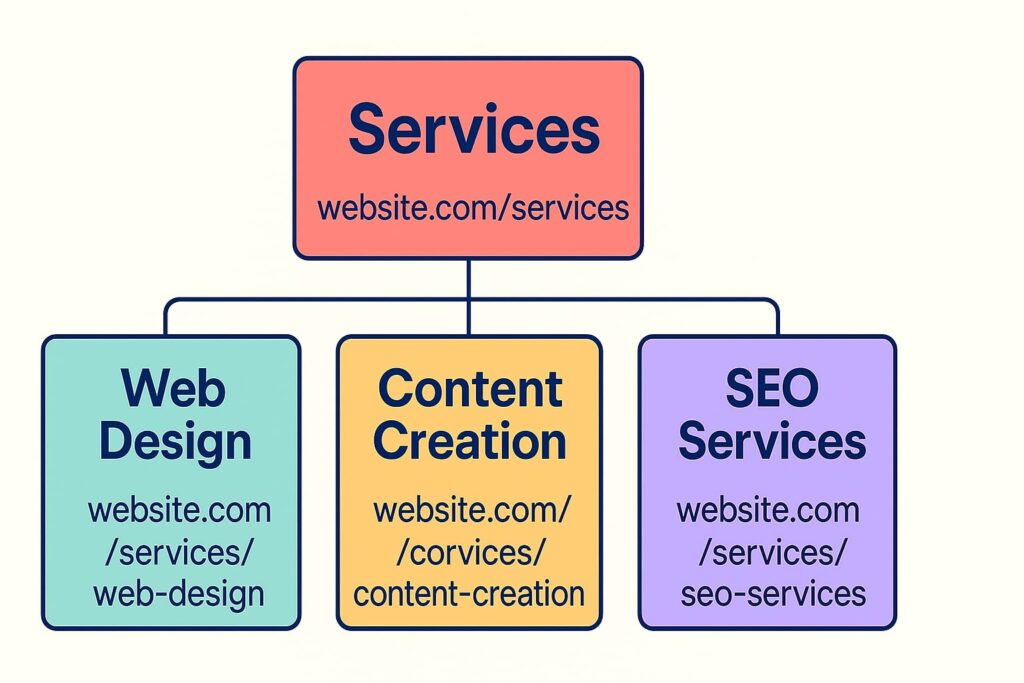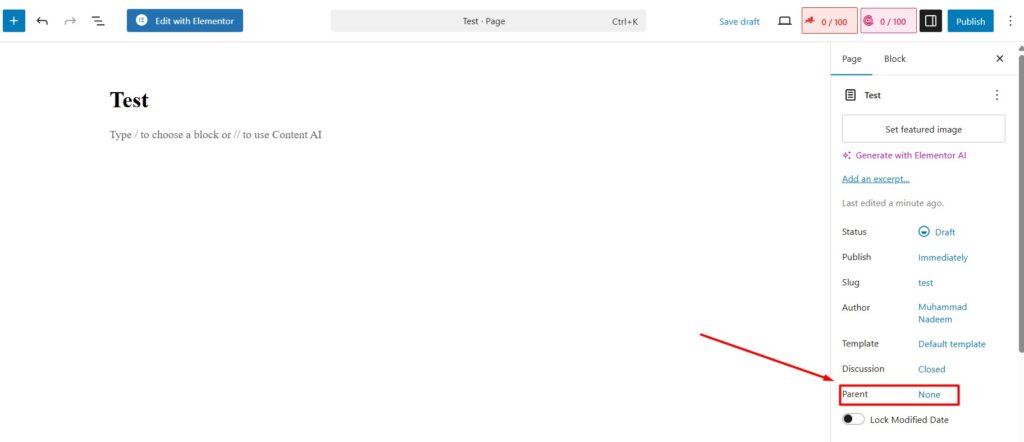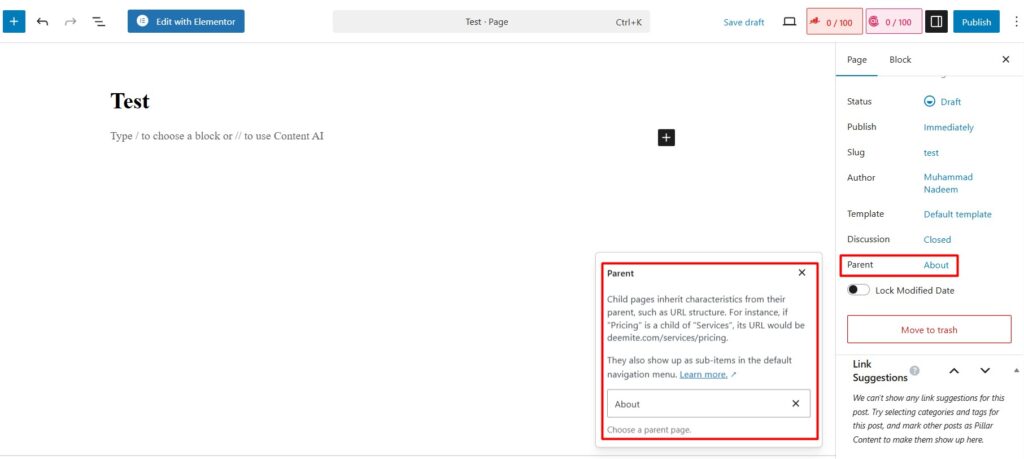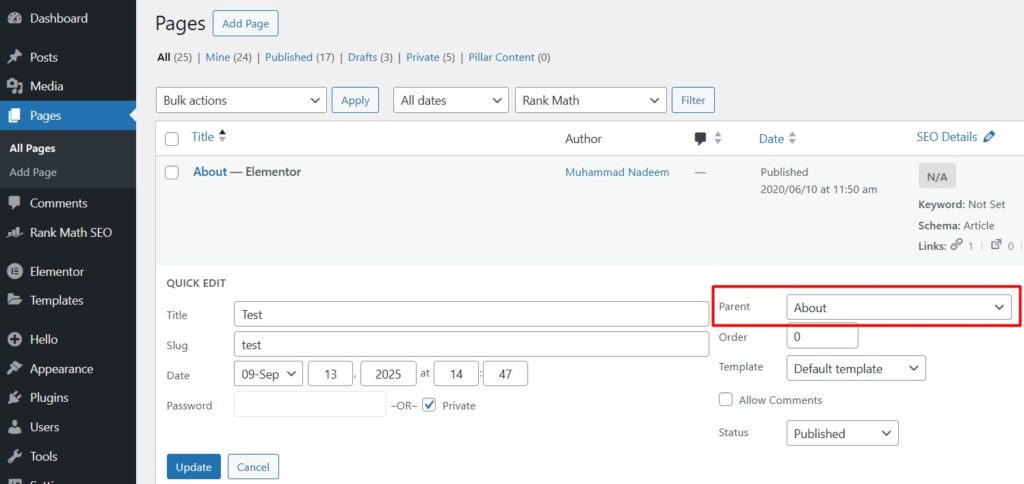A subpage, also called a child page, is a subordinate page nested within or under a main or parent page on a website. It forms a hierarchical structure, allowing web content to be categorized and presented in a more organized manner.
With the increasing complexity and volume of information, organizing web content has become crucial to providing visitors with a seamless browsing experience.
One effective method for achieving this is using subpages or child pages.
In this blog, we will learn what is a subpage, its benefits, and how to implement them effectively to optimize website content organization.
Let’s get started!
How Subpages Work (Subpage Explanation and Examples)
Subpages are typically linked to their respective parent pages, enabling visitors to access more detailed or specific information.

For example, let’s say you have a website with the main page “www.example.com,” and on that website, you have different sections such as “About Us,” “Contact,” “Services,” and “Blog.”
Each of these sections could be considered a main page. Now, let’s say within the “Services” section, you have more specific pages like “Web Development,” “Graphic Design,” and “Marketing.”
These pages would be referred to as subpages because they are nested under the main “Services” page.
The URL structure typically reflects this hierarchy. For example:
- Main page: www.example.com/services (Services page)
- Subpage 1: www.example.com/services/web-development (Web Development page, a subpage of Services)
- Subpage 2: www.example.com/services/graphic-design (Graphic Design page, a subpage of Services)
Read Also: How to Change the Order of Pages in WordPress?
Benefits of Using Subpages
Using child pages in website design brings various advantages that improve user experience and overall website performance.
1. Subpages Improve Content Organization
Subpages enable the categorization of content into relevant sections, making it easier for visitors to navigate and find the information they seek. By presenting content in a structured manner, websites become more user-friendly and inviting.
2. Subpages Enhance User Experience
A cluttered website can overwhelm users and drive them away. Subpages reduce information overload, presenting content in a concise and digestible manner. Visitors can focus on the content that interests them most without feeling lost or confused.
3. Subpages Help in SEO
Search engines recognize the structure of a website, and well-organized child pages can positively influence search engine rankings.
By targeting specific keywords and topics on subpages, website owners can improve their chances of appearing in relevant search results.
How to Create a Subpage in WordPress?
Creating a subpage in WordPress is simple and straightword. You don’t need any additional plugin or extra code to create subpages in WP.
All the subpages settings are available by default in WordPress.
Let’s learn step by step to create a subpage with visuals.
1. First click on “Add Page” button if your adding new page or simply “Edit” an exiting page(You can find “Edit” button under page name).

2. Now in the Gutenberg editor screen you can see “Parent” option at bottom right corner – click on it.

3. After clicking “Parent” it will open a popup which will allow you to select a parent page , in the image you can see I have added “About” page as parent page for my “Test” page.

4. Now click on “Publish” or “Save” button to publish the page. Now return back to pages screen and you will the new pages is added as child page. As you can see in below image the “Test” page which we have created as a child page of “About” page is showing directly below “About” page with an “em dash” before”. The child pages will show directly below parent page.

The second and more simple method is using “Quick Edit” method.It will work if you have already parent and child pages. For this simply hover over a page then click on “Quick Edit” button(As shown in image below) and a new box will open with more details. Then you will see a parent option on right side (Shown in image below). Click on selection box and select your parent page and hit update. Done!
You can also add another child page to a child page. The process is same. For example if you want to add child page under “Test” page simply follow the process as we did already. The child page of “Test” page will show under it with two ’em dashes’ something like this “–Test2”.


How to Implement Subpages Effectively?
To maximize the benefits of subpages, website owners must implement them strategically and adhere to best practices.
1. Choose the Right Subpage Structure
Create a parent page, then link it to your sub or child pages. If you don’t know how to create a subpage, you can read this guide on How to Add a Subpage in WordPress.
2. Create User-Friendly URL Structure
Create user-friendly and SEO-friendly URLs for subpages. Use descriptive keywords in the URL to help users and search engines understand the page’s content. Avoid lengthy or cryptic URLs, as they may deter visitors.
3. Make Clear Navigation and Interlink Subpages
Ensure that subpages are easily accessible from the main pages through clear navigation menus. Internal linking between related content on different subpages can improve the overall user experience and help search engines understand the relationships between pages.
Examples of Subpage Usages
Let’s explore how different types of websites can effectively use subpages to organize their content:
1. Subpage Example in Business Websites
Subpages for product or service categories: e.g., www.example.com/products/widgets
2. Use of Child Pages in Educational Websites
a. Course-specific subpages: e.g., www.example.com/courses/math101
b. Faculty and Staff subpages: e.g., www.example.com/faculty/professor-smith
3. Uses of Subpages in Blogging
a. Categorizing blog posts using subpages: e.g., www.example.com/blog/technology and www.example.com/blog/travel
b. Creating archive subpages for past content: e.g., www.example.com/blog/archive/2022
Common Mistakes to Avoid while Creating Subapages
While subpages can significantly enhance website organization, some pitfalls should be avoided:
1. Avoid Overusing Subpages
Creating too many subpages can lead to a convoluted structure and overwhelm users. Strike a balance between organizing content and maintaining a straightforward navigation experience.
2. Avoid Poorly Organized Subpage Structure
Ensure that the subpage hierarchy is logical and intuitive. Visitors should be able to find content without confusion or frustration.
- Keep important subpages ≤3 clicks from home via menus/breadcrumbs.
- Use descriptive slugs: /services/web-design/ over /services/page-2/.
- Cross-link sibling subpages and link each child back to its parent (helps users and bots).
Subpage vs Subdirectory vs Subdomain
| Thing | What it is | URL pattern | Typical use |
|---|---|---|---|
| Subpage | Child page under a parent page | /parent/child/ | Structure content within a site |
| Subdirectory | Folder under root domain | /blog/, /services/ | Organize sections; inherits domain authority |
| Subdomain | Separate hostname | blog.domain.com | Separate apps/audiences; often treated as separate entity |
Subpage vs. Landing Page: Understanding the Difference
While subpages organize content within a website, landing pages serve a different purpose. Landing pages are standalone pages designed for specific marketing campaigns or to capture leads.
Unlike subpages, which are part of a website’s overall structure, landing pages are often disconnected from the main navigation.
Conclusion
Subpages are vital in organizing web content, offering several benefits to website owners and visitors alike.
By implementing subpages effectively and avoiding common mistakes, website owners can optimize their content organization and provide a more pleasant experience for users.
So, whether you’re a business owner, educator, or blogger, consider utilizing subpages to enhance your website’s functionality and user-friendliness.






